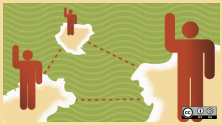The scientific community builds upon open access and open information. Recalling the famous quote in a 1675 letter by Isaac Newton: "if I have seen further [than others], it is by standing on the shoulders of giants." The scientific community has built our collective knowledge of the world around us on the information shared by those who came before us, and that is still the case today.
Looking back at the past year examining open source science and sustainability here on Opensource.com, many of the top articles on this topic touched on aspects of climate change. And that’s a good thing to see. We’re all in this together when solving this global problem. No one benefits when the solutions to climate change are locked up in proprietary solutions. In order to succeed, we need to spread the solutions far and wide to enable a truly global effort to fight back and save our planet.
Without further ado, here is a look back at some of the highlights from this year in science and sustainability.
Reuse old hardware with Linux
First, David Both discusses keeping old hardware alive in How Linux rescues slow computers (and the planet). In this article, David discusses how the use of Linux can extend the usable lifetime of a computer, keeping it out of landfills or recycling centers for longer. In addition, using non-proprietary hardware and avoiding non-standard parts can make it easier to find replacement parts and extend a computer's lifetime even further. These steps can help reduce the environmental impact of computers and prevent unnecessary waste.
Eco-friendly projects with open source
Next up, Lauren Pritchett takes readers through 11 open source ideas for being more eco-friendly in 2022. Here, Lauren rounds up a slew of interesting software and hardware tools. First, she shares several Raspberry Pi projects for monitoring and automating the physical environment around us, from smart thermostats to greenhouse gas trackers. Then, she explores various tools for exploring the world around us including plant identification, stargazing, and tackling litter, before finally showing how 3D printing and open source can assist in soil science.
Reduce waste in web design
So much of our days are spent in web browsers, but have you ever considered the impact of webpages themselves? Tom Greenwood shows us 5 open source tips to reduce waste in web design. From reducing unnecessary images to choosing better formats, removing autoplaying videos, and more, these tips don’t just make web pages more efficient, many times they also help keep pages faster-loading and a more pleasant overall experience for readers.
Open data for the planet
Next, straddling the dual goals of promoting a better understanding of the planet and working to keep it a liveable place, Tobias Augspurger shows 4 ways you can preserve the Earth's livability with open source. In this article, Tobias looks at various projects that can help people make use of open data and interpret it ourselves to observe our planet and the risks to its future.
Funding open source sustainability
Funding is always an important challenge for scientific research to overcome. Joshua Pearce takes a look at how The National Science Foundation bets big on open source. Through a program called Pathways to Enable Open-Source Ecosystems (PEOSE), the NSF granted $21 million this year to explore open source development. This program seeks to create new self-sustaining open source ecosystems, promoting future innovation in science and technology.
Sustainability with the Linux desktop
Can your desktop environment help promote sustainability? Seth Kenlon reports on how Linux KDE receives the first-ever eco-certification for Okular. Specifically, the Okular tool is a universal viewer that works with a slew of different file formats. By giving users control of the software they install on their computers, reducing bloat, and keeping old machines usable, KDE is putting sustainability into practice in software.
These aren’t the only articles covering sustainability and science this year. Be sure to also check out Tobias Augspurger’s How open source supports businesses' impact on climate change, Christopher Snider’s How radical transparency is transforming open source healthcare software, Hannah Smith’s How open source leads the way for sustainable technology, and Aleksandra Fedorova’s Upstream first or the path lifting property of a covering space for even more great reads.
And that’s it for the look back at the year in open source science and sustainability. Know of a great project you wish had been covered here? Let us know in the comments and consider submitting your own article.







Comments are closed.